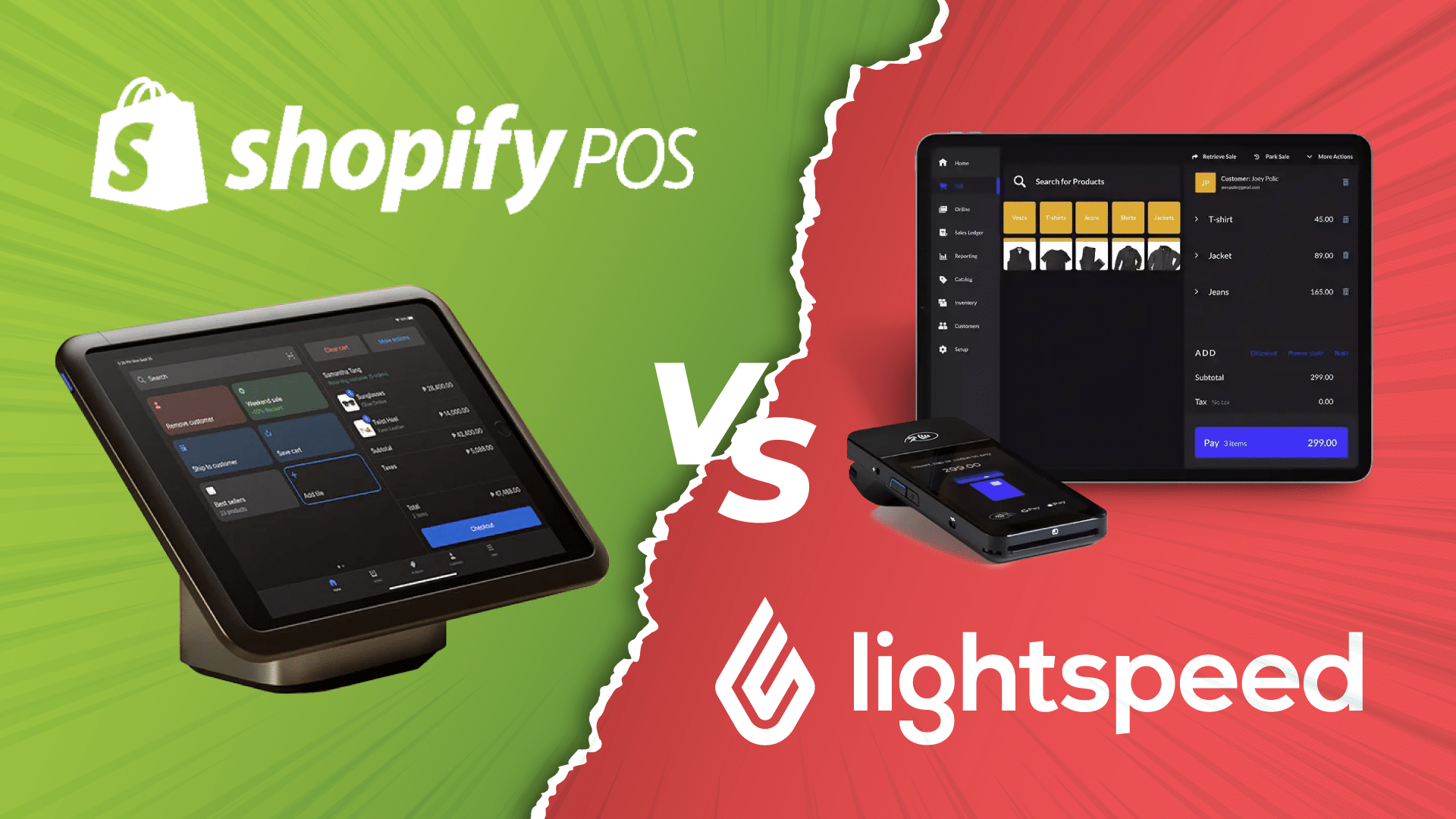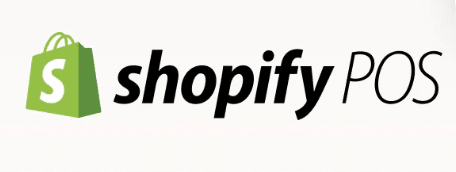Selecting the right POS system is crucial for businesses looking to streamline operations and enhance sales. Two leading contenders are Shopify POS and Lightspeed. While both offer robust features, they cater to different business needs.
Shopify POS shines with its seamless integration into the Shopify eCommerce platform, making it an excellent fit for online retailers seeking an easy-to-use solution. Lightspeed, on the other hand, excels in robust retail inventory management, advanced reporting, and industry-specific tools, better suiting larger brick-and-mortar operations.
This comprehensive guide dissects the key differences between Shopify POS and Lightspeed to help you determine which system better aligns with your business requirements. From pricing and features to usability and customer support, we’ll provide an in-depth analysis to ensure you make the right choice of POS.
Shopify POS vs. Lightspeed: Quick Product Reviews
Here’s a product review comparing Shopify POS and Lightspeed:
Software Advice Score | 4.6/5 | 4.1/5 |
Monthly Subscriptions | From $39 to $299 monthly. Or $2,300/month for more complex businesses. | Retail: $89 to $239 Restaurant: $69 to $399 |
Free Trial Duration | 3-Day | 14-Day |
Ease of Use | Very intuitive, user-friendly interface | User-friendly, but may have a steeper learning curve |
Industry Focus | Shopify POS can be a good fit for many retail businesses, especially those that value a seamless eCommerce connection | Lightspeed focuses on the retail, appointment, and hospitality industries |
Customer Support | 24/7 email and chat support, additional phone support for higher plans | 24/7 phone and email support & video tutorials |
Inventory Management | Seamless integration with Shopify's eCommerce platform | Robust inventory management features, especially for serialized types of businesses |
eCommerce | Integrates with the Shopify online store | Offers its own eCommerce solution |
Integrations | Integrates with various apps in the Shopify ecosystem | Integrates with a wide range of third-party apps |
Processing Fees | Shopify Payments (their built-in processor) has lower fees (2.4% - 2.9% + $0.30) than third-party processors | 2.6% + 10 cents (in-person), 2.9% + 30 cents (online), custom rates for high volume |
Pros | Affordable entry plans, integrated with Shopify eCommerce, easy to use | Powerful inventory management, advanced features like work orders, multi-device access |
Cons | Lacks advanced inventory features, mobile-only | More expensive, separate systems for retail and eCommerce can be cumbersome, and lengthy contracts |
Looking for a Lightspeed Retail or Shopify POS alternative? Try KORONA POS – a powerful alternative for your business needs.
Speak with a product specialist and learn how KORONA POS can power your business needs.
Shopify POS vs Lightspeed POS: How to Choose the Right Point of Sale
Choosing between Shopify POS and Lightspeed POS depends on your business’s specific needs (you may also want to see how Lightspeed compares to Clover for your business needs). Shopify POS is ideal for businesses already integrated with Shopify’s e-commerce platform, offering seamless online and in-store sales management, an intuitive interface, and extensive app integrations. On the other hand, Lightspeed POS stands out for its advanced inventory management and multi-location POS capabilities. Let’s take a deep dive into each platform and learn which one is the best fit for your business.
Choose Shopify POS If:
- You have an existing Shopify eCommerce store and want seamless integration to manage online and in-store sales
- You prioritize the simplicity and user-friendliness of the Shopify ecosystem
- You run a small to medium-sized business without extensive inventory management needs
- You primarily sell online
Choose Lightspeed POS If:
- You require robust inventory management, such as serial number tracking, purchase order management, and advanced reporting capabilities
- You operate in the retail or hospitality industry and need industry-specific features
- You have an extensive product catalog or multiple locations to manage
- You prefer a more comprehensive solution with advanced employee management tools
- You operate primarily through a brick-and-mortar store
Ultimately, Shopify POS excels in its tight integration with Shopify’s eCommerce platform, making it ideal for businesses with an online presence. On the other hand, Lightspeed POS shines with its powerful inventory management software, reporting, and industry-specific features, catering better to larger businesses or those in the retail and hospitality sectors.
Shopify POS vs Lightspeed: Pricing, Costs, Fees, and Hardware
In this section, we’ll dissect the costs, fees, and POS hardware associated with both Shopify POS and Lightspeed, giving you a clear picture of the financial investment required for each platform.
Shopify POS Pricing
Shopify offers a four-tiered pricing structure for its point-of-sale system: Basic, Shopify, Advanced, and Plus. Below is a look at the details of each Shopify’s pricing plan as well as some information on Shopify’s hardware and credit card processing rates.
Shopify pricing structure
Basic
($29/month) | Shopify
($79/month) | Advanced ($299/month) | Plus ($2300) on a 3-year term |
|
|
|
|
Hardware kits
- Shopify Tap & Chip Card Reader: $49
- Shopify POS Go: $299
- POS Terminal Countertop Kit for USB-C Tablets: $459
- POS Terminal Countertop Kit for Lightning iPads: $459
- Wired countertop bundle (Android only): $999Socket Mobile 2D Bluetooth Barcode Scanner (S720):$269
Shopify processing
Basic
($29/month) | Shopify
($79/month) | Advanced ($299/month) | Plus ($2300) on a 3-year term |
|
|
|
|
Lightspeed Pricing
Lightspeed offers several different pricing structures based on the business type and operational needs. Notably, Lightspeed offers discounts on annual plans for all retail plans but does not for any restaurant plans. Additionally, this section explores more specifics on the hardware pricing and credit card processing rates for Lightspeed.
Lightspeed Retail Pricing POS Plans
Lightspeed Retail is designed for apparel, jewelry, sporting goods, toys, vape, multi-store, bike, CBD, electronics, gift stores, and furniture stores. Its pricing structure accommodates businesses of various sizes through its three unique plans:
Basic
$109/mo
For small businesses or startups needing basic retail POS functionalities
Inventory management for tracking products
Basic reporting tools to monitor sales and performance
Free onboarding session to assist in the setup
Access supplier catalogs
Core
$179/mo
For growing retailers with moderate inventory and reporting needs
Advanced reporting and analytics
Mobile scanner app
Lightspeed Live app
Mobile scanner app
Advanced sales, staff, and inventory reports
Accounting, eCommerce, and marketing integrations
Plus
$339/mo
For medium to large retailers requiring advanced inventory and customer management, complex functionality, and multi-location management
Personalized onboarding and training
Integrated forecasting
Raw API access
Lightspeed Restaurant Pricing POS Plans
Lightspeed Restaurant POS caters to hospitality businesses, including cafes, quick-service restaurants, full-service restaurants, hotels, and fine dining establishments. There are four unique plans for restuarants:
Starter
$69/mo
For cafes, bakeries, and other quick-service restaurants that require basic table service
Customizable POS
Menu manager
Floor plans
Multiple order printers
Modifiers
Advanced Insights
Integrated payments
Take out and delivery
Essential
$189/mo
For small cafes and single-location restaurants that need more inventory control
Basic order and table management
Order and pay at table
Lightspeed Live app
Online ordering
Key performance report
Slow and top sellers
Lightspeed Pulse mobile app
Premium
$399/mo
For growing restaurants that need more substantial management capabilities
Multiple revenue center support for hotels
Custom processing rates available
Raw API access
Enterprise
Customized pricing
For high-volume restaurants and multi-location establishments
Multi-location management for seamless operation across sites
Advanced POS analytics and customer insights
Full suite of integrations for payroll, inventory, and customer loyalty
Personalized software and hardware package
Unlimited launch and consultation services
Lightspeed POS Hardware Pricing

Lightspeed sells a wide range of equipment, including cash drawers, receipt printers, Bluetooth scanners, a Lightspeed iPad stand, and receipt paper.
You’ll notice some overlap across their hardware offerings, so check each item’s operating system and software compatibility before purchasing. The prices of some of Lightspeed POS’s hardware options are listed below:
Lightspeed Stands
The POS hardware stand is a physical device that securely positions a POS, like a tablet or terminal, at a checkout counter. Below are a few of the stands that Lightspeed offers:
1. Lightspeed Stand for iPad
Lightspeed’s $169 hardware stand features a sleek design with a stable metal base, a magnetic swivel for customer interaction, and compatibility with iPad 10th gen, Air 5th gen, and Pro 11″ 5th/6th gen. It includes a USB-C cable.

2. Lightspeed Stand with Payments
This $199 iPad stand features a stable base and card reader enclosure, making it ideal for POS setups. It fits the 10.2″ iPad and is compatible with 7th, 8th, and 9th-generation models.
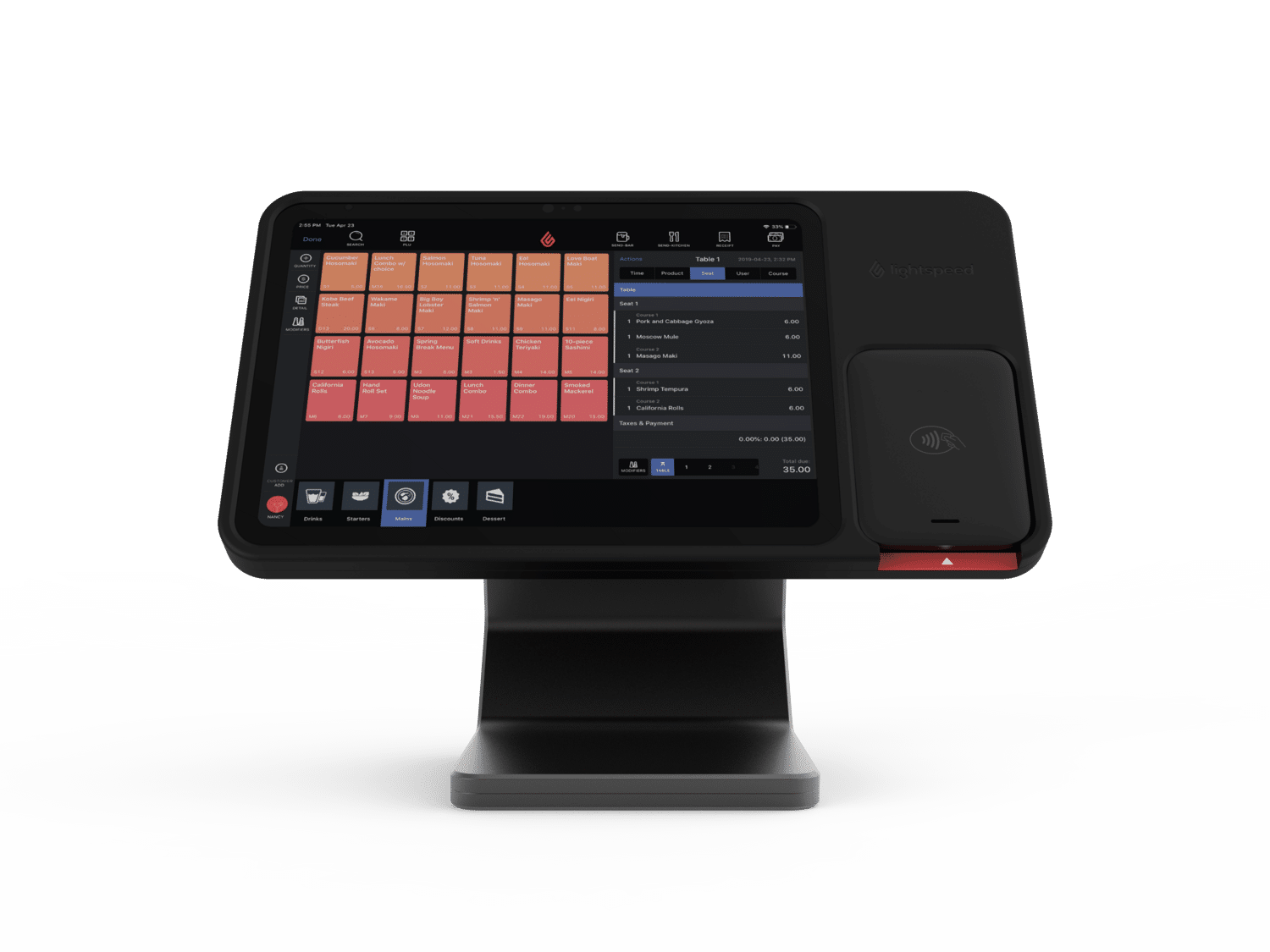
3. Universal Stand for Tablets
The Universal Tablet Stand costs $89 and features a swivel base for customer-facing displays, quick tablet removal for portability, and clear Lightspeed branding. It includes a 180º USB-C cable and supports tablets from 7 to 13 inches.

Lightspeed Terminals
The POS terminal is the hardware that lets merchants process payments. Modern POS terminals range from smartphones with plugged-in card readers to countertop terminals that print receipts, scan bar codes, and more. Here’s what Lightspeed offers:
1. Smart Terminal with Printer, Hospitality
A sleek terminal for processing transactions in hospitality settings, with an integrated printer for receipts. This smart terminal with a printer costs $399.
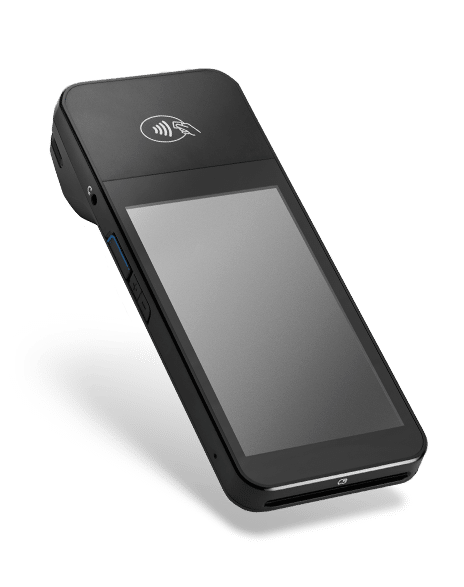
2. Smart Terminal, Retail
This $329.00 countertop reader connects to Lightspeed Payments via the internet. It’s built for a casual retail checkout experience.
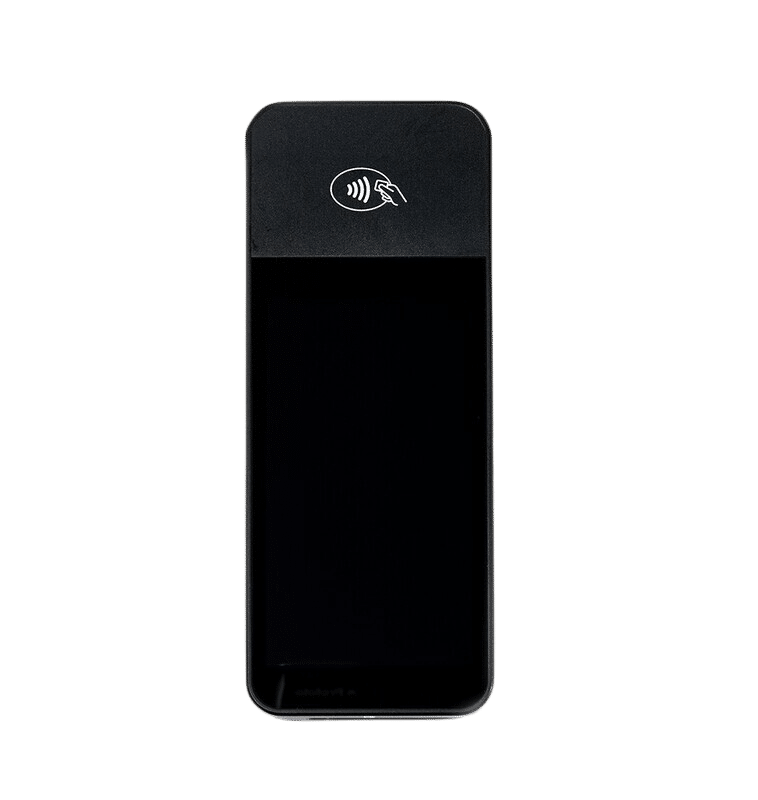
3. Mobile Terminal
This Verifone Mobile Terminal costs $399 and pairs with Lightspeed Hospitality and Golf. It features a quick processor and a touchscreen, making it easy for customers to pay from anywhere.

4. Smart Terminal; Hospitality (US)
The AMS1 Smart Terminal is an all-in-one payment terminal that promotes fast and mobile payments. It’s handheld and portable, making it easy for Lightspeed users to take payments on the go.

Lightspeed Barcode Scanners
A barcode scanner is a device — typically handheld — that reads barcodes and sends data to a computer. It’s used alongside a POS system for inventory management and asset tracking. Here are some of Lightspeed’s barcode scanners:
1. Lightspeed Bluetooth Barcode Scanner
The Bluetooth Barcode Scanner costs $399. It pairs seamlessly with Lightspeed Golf and Retail. The device is small, lightweight, and equipped with continuous scanning capabilities.
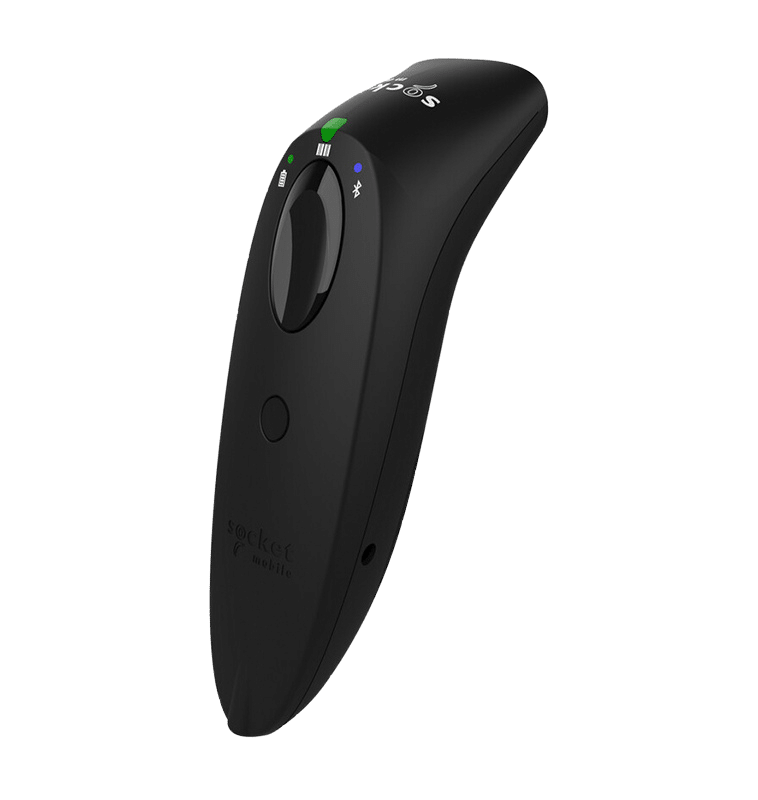
2. USB Barcode Scanner with Stand
The USB Barcode Scanner with Stand (Zebra DS2208) costs $149. It can scan all barcodes, gift cards, and driver’s licenses. Because of the stand, users can enjoy hands-free scanning capabilities.
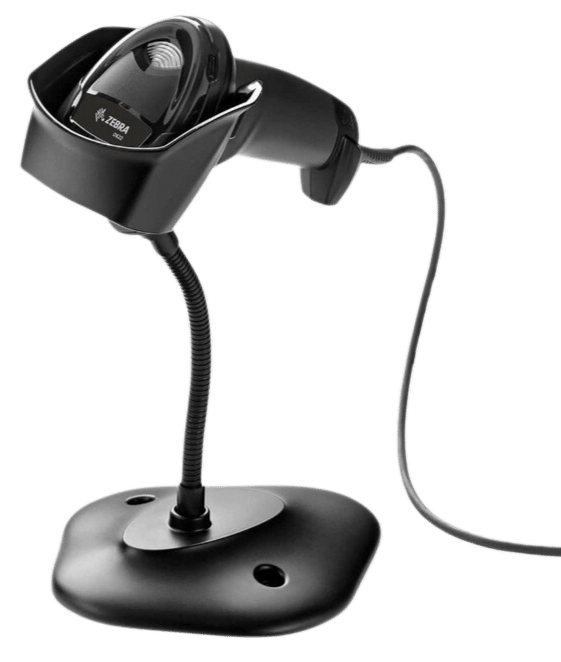
Lightspeed Miscellaneous Hardware
There’s a whole array of lesser-known hardware that goes into a POS system. Learn about some of the miscellaneous hardware that Lightspeed offers:
1. Lightspeed Kitchen Bumpbar
This Lightspeed Kitchen Bumpbar costs $199. It is used to control the Lightspeed Kitchen display. The Bumpbar features keys for moving tickets to the next or previous cooking state, ticket number selection, ticket cancellation, and more.
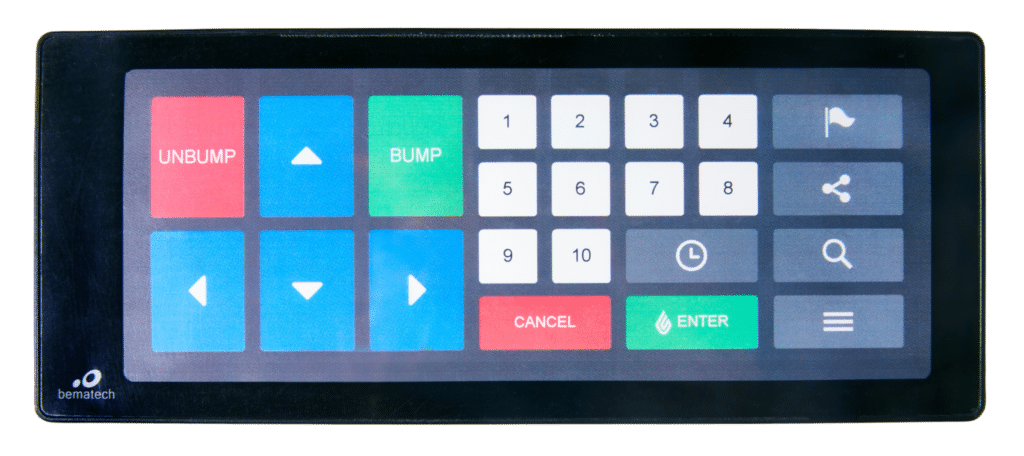
2. Mobile Tap (v2, Hospitality)
The $49 Mobile Tap is a compact Bluetooth card reader for iPad and Lightspeed Payments, supporting swipe, EMV, and tap-to-pay transactions.

3. Lightspeed 16″ Cash Drawer (APG Minota)
This Lightspeed cash drawer costs $129. It is durable, has ample space for organizing bills and coins, and is compatible with most POS systems.
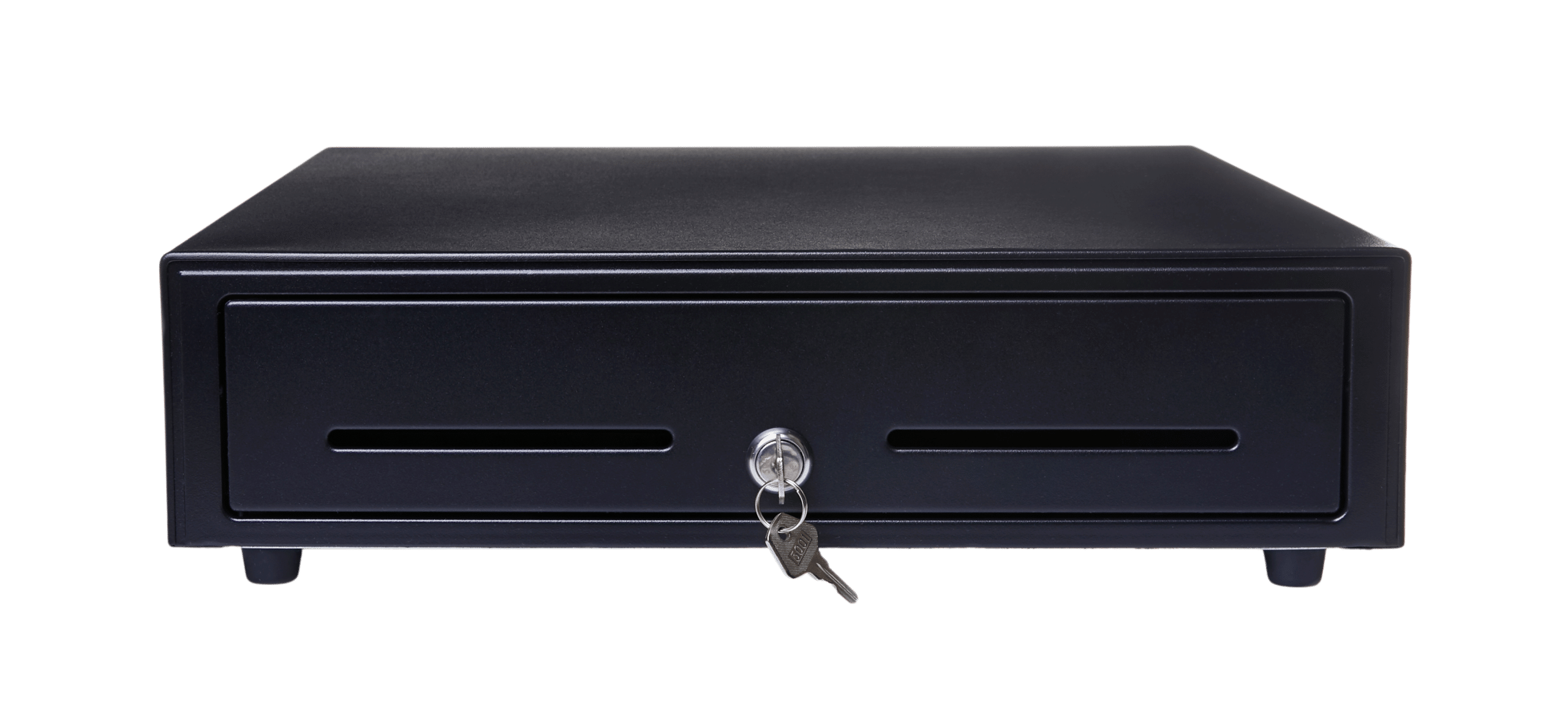
4. Lightspeed Lite Server
The Lightspeed Lite Server is featured within Lightspeed Lite’s networking hardware, coming in at $429. The Lite server maintains a local database and connectivity, continually backing up user data to Lightspeed servers. During an internet outage, users can continue essential business without disruption.
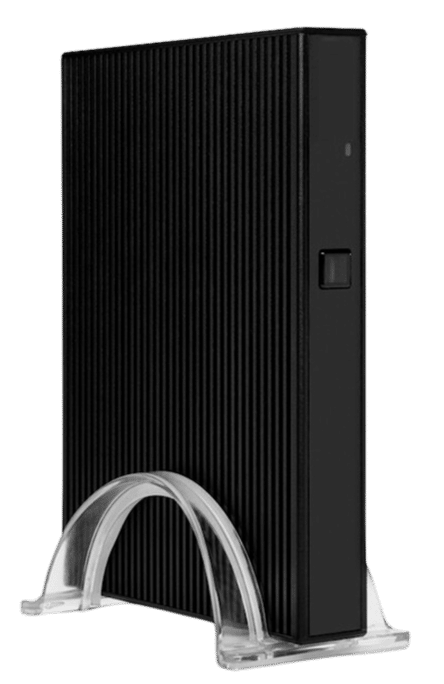
5. All-In-One Receipt Printer (TM30 Gen 3)
Lightspeed’s All-In-One Receipt Printer is a TM-M3III thermal receipt printer compatible with Lightspeed’s X-Series, R-Series, K-Series, and L-Series products. It offers a range of connectivity options: USB, Ethernet, Dual WiFi, and Bluetooth.

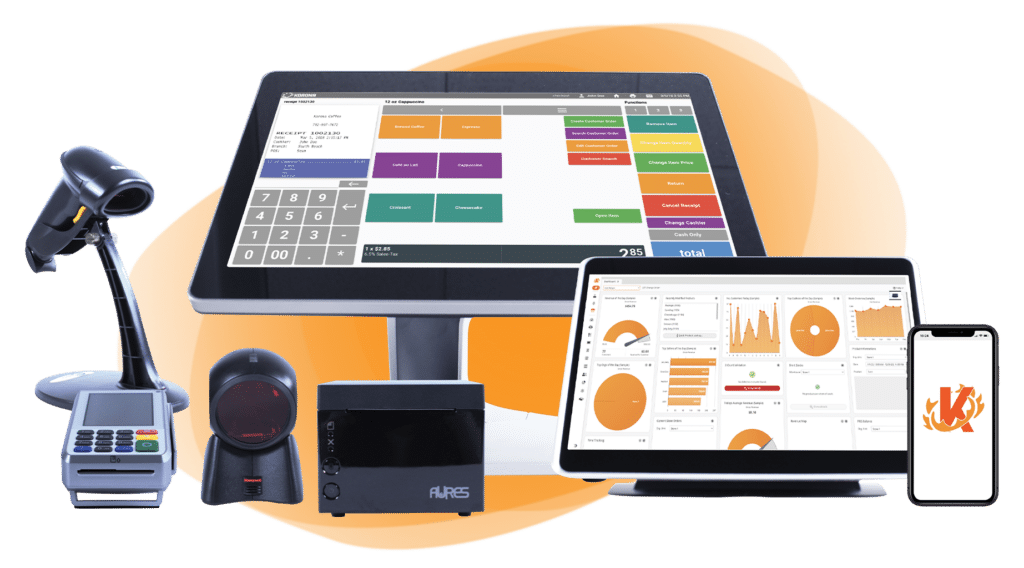
Build Your Own POS Setup
Whether you run a café, retail store, or event booth, we have the point of sale hardware designed for your specific needs. Start building your ideal POS system now.
Lightspeed Payment Processing Fees
Lightspeed’s payment processing fees depend primarily on the region, the business type, and the volume of transactions processed. Generally, for businesses in the United States, Lightspeed Payments charges a flat rate of 2.6% + $0.10 per transaction for card-present transactions and 2.9% + $0.30 for card-not-present transactions, such as online or manually entered payments.
Below is an estimate of monthly transactions based on your monthly transaction volume:
Monthly Transaction Volume (in USD) | Estimated Monthly Transaction Fee (in USD) |
$5,000 - $34,999 | $200 |
$35,000 – $99,999 | $400 |
$100,000 – $124,999 | $560 |
$125,000 – $149,999 | $680 |
$150,000 – $174,999 | $810 |
$200,000 – $249,999 | $1,120 |
$250,000+ | Contact an Account Manager |
Source: Lightspeed Payment Transactions
Third-Party Processors
Lightspeed POS allows businesses to use third-party payment processors if Lightspeed Payments does not meet their needs.
Choosing a third-party processor will enable businesses to negotiate rates, leverage existing relationships, or integrate specialized payment solutions. However, merchants that opt for a third-party processor will face significantly higher subscription rates and fees from Lightspeed.
Shopify POS vs Lightspeed: POS Features
Each solution has its unique strengths and caters to different business needs. In this section, we’ll evaluate the key POS features offered by Shopify and Lightspeed.
Inventory Management | Basic inventory management capabilities, suitable for small to medium-sized businesses | Robust inventory management with advanced features like multi-location tracking, product variants, and stock alerts |
Sales Reporting | Offers basic sales reporting tools with insights into sales trends and performance | Provides comprehensive sales reporting with customizable reports, analytics, and insights into customer behavior |
Customer Management | Allows basic customer management with the ability to capture customer information and create customer profiles | Offers advanced customer management features, including customer profiles, purchase history, and targeted marketing tools |
Payment Processing | Integrated payment processing with Shopify Payments and support for other payment gateways | Integrated payment processing with Lightspeed Payments and support for various payment methods, including credit/debit cards, mobile payments, and gift cards |
eCommerce Integration | Seamlessly integrates with Shopify's eCommerce platform for omnichannel retailing | Offers eCommerce integration through Lightspeed eCommerce, allowing businesses to sync inventory, orders, and customer data across online and offline channels |
Customization | Limited customization options for the POS interface and workflows | Highly customizable POS interface and workflows, allowing businesses to tailor the system to their specific needs |
Hardware Compatibility | Compatible with a wide range of hardware, including iPads, iPhones, and various POS peripherals | Supports a variety of hardware options, including iPads, desktops, and specialized POS terminals |
Shopify POS vs Lightspeed: Usability
When it comes to usability, both Shopify POS and Lightspeed Retail offer user-friendly interfaces, but they have some differences in their approach and features:
What Makes Shopify POS User-Friendly
- Simplicity: Shopify POS is designed with simplicity, making it easy for non-technical users to navigate and perform basic tasks. The interface is clean and intuitive, with a focus on minimalism.
- Intuitive navigation: The Shopify POS app follows a straightforward workflow, guiding users through the sales process step by step. The interface is optimized for touch-screen devices, making it easy to use on tablets or mobile devices.
- Limited customization: While the Shopify POS interface is user-friendly, it may offer fewer customization options compared to Lightspeed. Shopify prioritizes a standardized experience across all its platforms, which can be seen as both an advantage and a limitation.
What Makes Lightspeed User-Friendly
- Feature-rich interface: Lightspeed offers a more feature-rich interface, catering to businesses with more complex operations. The interface provides access to various tools and settings, which can initially overwhelm some users.
- Customizable views: Lightspeed allows users to customize their workspace by rearranging panels, resizing windows, and creating custom layouts. This flexibility enhances productivity for users who prefer personalized setups.
- Steep learning curve: With its comprehensive features, Lightspeed Retail may have a steeper learning curve than Shopify POS. Users may need more training or time to become proficient with all the available options.
Overally, in terms of usability, Shopify POS excels in simplicity and ease of use, making it an attractive option for small businesses or those with minimal POS requirements. Lightspeed Retail, on the other hand, offers more advanced POS features and customization options, which is beneficial for businesses with more complex needs but may require a longer learning curve.
Shopify POS vs Lightspeed: eCommerce
Both solutions provide eCommerce options, but Shopify is built primarily for eCommerce sellers and has far more advanced and seamless functionalities for online selling.
Feature | Shopify POS | Lightspeed POS |
Design customization | Yes - more extensive theme options, customizable | Yes - provide 30 easy-to-use professional themes |
eCommerce platform | Yes - available in all plans | Yes - available only in Core and Plus plans |
Syncs with in-person POSAdd New | Yes | Yes |
Omnichannel channel integrations | Facebook, Instagram, Pinterest, Buy Button, and TikTok | Facebook, Twitter, Pinterest, Instagram, Google, Amazon, eBay, and TikTok |
Shipping management tools | Yes - provides third-party calculated shipping rates | Yes |
eCommerce integrations | Yes | Yes |
International online sales | Yes | Yes |
Languages
| Up to 20 | 12 |
Dropshipping capabilities | Yes | No |
SEO Tools | Yes | Yes |
Multiple currencies | Yes | Yes |
Shopify POS vs Lightspeed: Customer Support
When it comes to customer support, Shopify POS emerges as the clear winner over Lightspeed. Despite both platforms scoring well in customer service, Shopify stands out for its consistently high levels of assistance. (This doesn’t mean, though, that Shopify outages aren’t common).
According to Software Advice’s scoring, Shopify POS received a higher rating of 4.5 compared to Lightspeed’s 4.0. Both software packages offer 24/7 customer support, advanced training, and advanced support options.
Numerous online reviews have criticized the quality of Lightspeed’s customer support. Many users have complained about long wait times before receiving assistance, and some have reported instances where the support team promised to follow up but failed to do so.
In contrast, Shopify POS appears to excel in customer service, as evidenced by the overwhelming majority of positive reviews.
See also our Shopify vs Square POS comparison.
Do you have trouble getting your POS customer service on the phone?
KORONA POS offers 24/7 phone, chat, and email support. Call us now at 833.200.0213 to see for yourself.
Which Point of Sale Should You Go For? Our Assessment
Choosing between Shopify POS and Lightspeed depends on your business’s specific requirements and scale.
If you’re a small to medium-sized business looking for a straightforward POS solution with seamless integration into an existing Shopify eCommerce platform, Shopify POS may be the better choice. It offers a user-friendly interface, basic inventory management, and easy eCommerce integration. Additionally, Shopify is likely a better fit if you are mainly an online retailer, but there are some good Shopify point-of-sale alternatives.
On the other hand, if you run a larger retail operation with more complex inventory management needs, advanced reporting requirements, and a desire for highly customizable POS workflows, Lightspeed’s POS Software will be the better option. Its robust features cater to businesses with multiple locations, extensive product lines, and a focus on detailed analytics and customer management.
Ultimately, consider your business size, growth plans, and specific feature requirements to make the best decision.
Alternatives to Shopify POS or Lightspeed: KORONA POS
KORONA POS is a versatile POS system that caters to a wide range of retail businesses, including liquor stores, convenience stores, smoke and tobacco shops, CBD stores, wineries, theme parks, and quick-service restaurants. Its comprehensive feature set makes it a compelling alternative to popular POS solutions like Shopify and Lightspeed.
With its versatility, rich feature set, award-winning customer support team, seamless online-offline integration, and payment processing flexibility, KORONA POS presents itself as a viable retail POS system alternative to Shopify and Lightspeed. Schedule a demo or start a free trial by clicking below to see how KORONA POS works.


